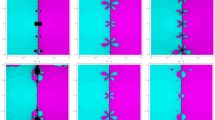Abstract
An accelerated substructuring reduction procedure for the iterated improved reduced system (IIRS) method is proposed. The iterated IIRS method can be combined with a substructuring scheme to provide an efficient methodology for large-scale eigenvalue problems. Not only can it reduce eigenvalue analysis errors through successive iterations, but the accuracy of the eigenanalysis is not sensitive to the selected master degrees of freedom. In practical structural eigenproblems, reducing the number of iterations can save a great deal of computation cost. The present substructuring technique modifies the iterative form of the transformation matrices in each substructure to achieve faster convergence. Applications of the present method to two numerical examples demonstrate that the proposed method can obtain lower eigensolutions of structures more accurately and efficiently, as compared with those of the current substructuring technique.
Similar content being viewed by others
References
Robert J. Guyan, Reduction of Stiffness and Mass Matrices, AIAA Journal 3 (2) (1965) 380.
Bruce Irons, Structural eigenvalue problems: elimination of unwanted variables, AIAA Journal 3 (5) (1965) 961–962.
J.C. O’Callahan, A new procedure for an improved reduced system (IRS) model, Proceedings of the 7th International Modal Analysis Conference (1989) 17–21.
Joshua H. Gordis, An analysis of the improved reduced system (IRS) model reduction procedure, Proceedings of the 10th International Modal Analysis Conference 1 (1992) 471–479.
L. E. Suarez and M. P. Singh, Dynamic condensation method for structural eigenvalue analysis, AIAA Journal 30 (4) (1992) 1046–1054.
M. I. Friswell, S. D. Garvey and J. E. T. Penny, Model reduction using dynamic and iterated IRS techniques, Journal of Sound and Vibration 186 (2) (1995) 311–323.
M. I. Friswell, S. D. Garvey and J. E. T. Penny, The convergence of the iterated IRS method, Journal of Sound and Vibration 211 (1) (1998) 123–132.
Z.-Qu. Qu and Z.-F. Fu, New structural dynamic condensation method for finite element models, AIAA Journal 36 (7) (1998) 1320–1324.
Zu-Qing Qu and R. Panneer Selvam, Efficient method for dynamic condensation of nonclassically damped vibration systems, AIAA Journal 40 (2) (2002) 368–375.
Z.-Q. Qu, Y. Jung and R. P. Selvam, Model condensation for non-classically damped systems — Part: Static I condensation, Mechanical Systems and Signal Processing 17 (5) (2003) 1003–1016.
Z.-Q. Qu, R. P. Selvam and Y. Jung., Model condensation for non-classically damped systems — Part II: Iterative schemes for dynamic condensation, Mechanical Systems and Signal Processing 17 (5) (2003) 1017–1032.
Yong Xia and Rongming Lin, Improvement on the iterated IRS method for structural eigensolutions, Journal of Sound and Vibration 270 (4–5) (2004) 713–727.
Maenghyo Cho and Hyungi Kim, Element-based node selection method for reduction of eigenvalue problems, AIAA Journal 42 (8) (2004)1677–1684.
Hyungi Kim and Maenghyo Cho, Two-level scheme for selection of degrees of freedom and semi-analytic sensitivity based on the reduced system, Computer Methods in Applied Mechanics and Engineering 195 (33–36) (2005) 4244–4268.
Crag, Jr. and C. Bampton,Coupling of substructures for dynamic analyses, AIAA Journal 6 (7) (1968) 1313–1319.
M. A. Aminpour, J. B. Ransom and S. L. McCleary, A coupled analysis method for structures with independently modeled finite element subdomains, International Journal for Numerical Method in Engineering 38 (21) (1995) 3695–3718.
N. Bouhaddi and R. Fillod, Substructuring using a linearized dynamic condensation method, Computer & Structures 45 (4) (1992) 679–683.
N. Bouhaddi and R. Fillod, Substructuring by a two-level dynamic condensation method, Computer & Structures 60 (3) (1996) 403–409.
Hyungi Kim and Maenghyo Cho, Improvement of reduction method combined with sub-domain scheme in large-scale problem, International Journal for Numerical Method in Engineering 70 (2) (2007) 206–251.
Dongsoo Choi and Maenghyo Cho, Iterated Improved Reduced System (IIRS) Method Combined with Sub-structuring Scheme-Part I: Undamped Structural Systems, Trans. of the KSME (A) 31 (2) (2007) 211–220.
Dongsoo Choi and Maenghyo Cho, Iterated Improved Reduced System (IIRS) Method Combined with Sub-structuring Scheme-Part II: Nonclassically Damped Structural Systems, Trans. of the KSME (A) 31 (2) (2007) 221–230.
M. A. Aminpour, An assumed-stress hybrid 4-node shell element with drilling degrees of freedom, International Journal for Numerical Method in Engineering 33 (1) (1992) 19–38.
Author information
Authors and Affiliations
Corresponding author
Rights and permissions
About this article
Cite this article
Choi, D., Kim, H. & Cho, M. Improvement of substructuring reduction technique for large eigenproblems using an efficient dynamic condensation method. J Mech Sci Technol 22, 255–268 (2008). https://doi.org/10.1007/s12206-007-1040-7
Received:
Revised:
Accepted:
Published:
Issue Date:
DOI: https://doi.org/10.1007/s12206-007-1040-7




